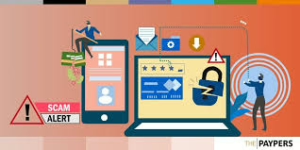In the rapidly evolving realm of digital finance, online banking has fundamentally transformed our approach to managing money. This unprecedented convenience, however, comes with a significant obligation for banks: the imperative to protect sensitive financial data. This detailed guide aims to explore essential safety measures that banks ought to adopt to ensure the security of their customers’ invaluable information against various potential threats. Additionally, it will provide valuable insights for both the fintech sector and individuals utilising mobile banking applications.

Understanding Online Banking Fraud
Recent studies indicate that a considerable number of individuals who fall victim to online banking fraud are often oblivious to the scams until it is too late. This stark reality underscores the urgent need for heightened awareness and education concerning the safety protocols surrounding online banking. The emergence of banking malware further accentuates the critical requirement for improved protective strategies. As instances of online banking theft escalate, it becomes imperative for the banking sector to innovate and adapt in response to this increasingly perilous environment.

A Closer Look: Phishing Attacks on Bank of America Customers
Consider a phishing attack targeting Bank of America customers to illustrate the vulnerabilities present in online banking. Understanding how such attacks unfold is essential for grasping the importance of robust online banking security practices. Phishing scams typically involve deceitful communications designed to trick users into revealing personal information or credentials, which can lead to unauthorised access to their accounts.
As we navigate this narrative of online banking safety, it is crucial to recognise that while technology offers remarkable conveniences, it also necessitates a vigilant approach to safeguarding our financial well-being. By equipping ourselves with knowledge and employing proactive measures, we can better navigate the complexities of digital banking and protect our assets from those who would exploit them.
In the year 2019, Bank of America found itself facing a staggering rise in the number of phishing attacks, witnessing an alarming 34% surge. A report from Vade revealed that the bank encountered 19,800 distinct phishing URLs, a notable jump from the 14,771 reported in the previous year. The nature of these attacks primarily revolved around security alerts—an all-too-familiar tactic within the realm of financial services phishing. Cybercriminals adeptly exploited the anxiety and urgency associated with alerts from financial institutions, increasing the likelihood that unsuspecting users would inadvertently click on malicious links. This dramatic increase serves as a testament to the ever-evolving strategies employed in phishing campaigns. It highlights the pressing need for enhanced cybersecurity measures designed to safeguard both users and financial organisations.
increasing the likelihood that unsuspecting users would inadvertently click on malicious links. This dramatic increase serves as a testament to the ever-evolving strategies employed in phishing campaigns. It highlights the pressing need for enhanced cybersecurity measures designed to safeguard both users and financial organisations.
What makes the phishing incident involving Bank of America particularly noteworthy is the calculated approach taken by the attackers, who went to great lengths to impersonate the bank through misleading emails. These fraudulent communications often utilised sophisticated methods to closely resemble official correspondence, fostering a false sense of trustworthiness among recipients. By leveraging the established reputation and credibility of Bank of America, the cybercriminals managed to deceive individuals into clicking on harmful links or divulging sensitive personal information. The phishing emails typically contained misleading narratives—urgent requests for security updates, prompts for account verification, or alluring offers—all crafted to spur recipients into immediate action. Once victims engaged with the deceptive content, they were often redirected to malicious websites or urged to reveal confidential information, such as their login credentials or other personal data.
In light of these growing threats, it has become increasingly clear that robust cybersecurity measures are essential for detecting and countering phishing risks. In response to these persistent challenges, Bank of America has taken proactive steps to advise its customers on how to protect themselves. The bank encourages its clients to remain vigilant, carefully verify the authenticity of any emails they receive, and refrain from clicking on any suspicious links. This guidance is vital in helping individuals safeguard their personal and financial information against the relentless tide of phishing attempts that continue to plague the digital landscape.
Shifting the focus to a more recent event, on November 10, 2023, the global financial sector was rocked by a significant incident involving the Industrial and Commercial Bank of China (ICBC), recognised as the largest bank in the world. This particular malware attack not only highlighted vulnerabilities within one of the most prominent financial institutions but also raised alarms about the overall security posture of banks worldwide. As details emerged about this unprecedented breach, it became evident that the implications extended far beyond ICBC itself, sending ripples throughout the entire financial community and underscoring the urgent need for enhanced protective measures against such malicious threats.
The recent cyberattack on ICBC, marked by the encryption of the bank’s files by nefarious individuals who subsequently demanded a ransom for their release, highlights not only a significant threat to the bank’s day-to-day functions but also raises alarms about the overall security and resilience of the financial services sector. This incident serves as a stark reminder that even well-established and reputable financial institutions are not shielded from cyber threats, regardless of their size or standing in the industry.
In light of this event, it becomes imperative for the financial sector to reassess its cybersecurity measures. The financial industry’s nature makes it particularly attractive to cybercriminals, who are often motivated by the potential for substantial profits derived from sensitive personal information or the disruption of vital services. As the industry grapples with the implications of the ICBC breach, it must consider how to bolster its defences against such attacks, ensuring that all banks have robust strategies in place to safeguard their operations and customer data.
It is crucial to prioritise security for those engaging in online banking. Our team of cybersecurity specialists stands ready to continuously fortify your online banking experience, providing ongoing support and enhancing protective measures.
To help you navigate this complex landscape, we invite you to schedule a complimentary consultation. As digital banking rapidly advances, so too are cybercriminals’ tactics. Consequently, financial institutions must adopt a comprehensive suite of advanced security protocols designed to shield customer information from cyber threats and unauthorised access. Understanding these intricate security frameworks is vital for customers, as it fosters trust in the safety of their financial transactions.
Among the essential security measures that banks should implement is data encryption. This technique serves as a cornerstone of protective strategies, converting sensitive information into a format that is incomprehensible to anyone without the appropriate decryption keys. By employing state-of-the-art encryption technologies, banks can create an impenetrable barrier around customer data, ensuring its confidentiality and integrity. This digital fortress acts much like a secret language understood only by the bank and its authorised users, effectively safeguarding sensitive information during online transactions.
Additionally, banks should incorporate two-factor authentication (2FA) to secure customer accounts further. This method involves an extra layer of verification, requiring users to provide a second piece of information—often a unique code sent to their mobile device—before they can gain access to their accounts. This added step significantly enhances security, making it much more difficult for unauthorised individuals to infiltrate accounts even if they manage to acquire login credentials.
As we navigate this ever-evolving digital landscape, it’s clear that vigilance and proactive measures are paramount in protecting both individual consumers and financial institutions alike. The lessons learned from incidents like the one involving ICBC will undoubtedly shape the future of cybersecurity within the banking sector, compelling all players involved to adapt and innovate in order to safeguard their customers’ trust and protect sensitive data from emerging threats.
FDIC Insurance: A Guardian of Your Deposits
The Federal Deposit Insurance Corporation, commonly known as the FDIC, serves as a vital protector of your hard-earned money. This insurance program assures individuals that their deposited funds are safeguarded up to a designated limit, functioning as a protective shield in the unfortunate event of a bank collapse. Such a guarantee instils confidence among banking clients, reassuring them that their financial resources are secure and bolstering their trust in the overall banking framework.

The Role of Anti-Fraud Departments
In the ever-evolving landscape of financial transactions, banks must establish robust anti-fraud units equipped with cutting-edge technologies and tools. These specialised departments play an essential role in scrutinising transactions in real time, allowing them to pinpoint any irregularities that could signal potential fraud swiftly. By employing sophisticated algorithms, these teams can effectively identify suspicious activities, enabling them to respond promptly to mitigate threats and uphold the security of customer accounts and assets.
The Importance of Automatic Sign-Out Features
Automatic sign-out functionalities represent a straightforward yet powerful strategy for reducing the likelihood of unauthorised access to online banking platforms. When a user remains inactive for a specified period, the system automatically logs them out of their online banking session. This precaution serves as a safeguard against lapses in attention or memory, thereby enhancing the overall security framework surrounding online banking interactions.

The Backbone of Fraud Monitoring
At the heart of a bank’s protective measures lies real-time fraud monitoring systems, which constitute a fundamental aspect of its security architecture. These systems leverage advanced algorithms to meticulously analyse transaction behaviours, swiftly identifying any anomalies that may suggest fraudulent conduct. The true strength of these systems lies in their ability to detect irregularities almost instantaneously, empowering banks to take immediate corrective actions to protect customer accounts and financial assets in their ongoing fight against cyber threats.
Seeking Expert Assistance for Enhanced Banking App Security
If you’re looking to fortify the security features of your banking application, look no further. We invite you to reach out to us for assistance in enhancing your app’s security capabilities, augmenting your team for project development, or even engaging our talented professionals to manage your application from inception to completion.
In today’s digital landscape, safeguarding your online presence begins with creating a formidable password. Individuals must construct a password that is not only intricate but also distinctly their own. Relying on easily accessible personal information—like dates of birth or family names—should be avoided at all costs. Instead, one should consider devising a password that intertwines a mix of uppercase and lowercase letters, numbers, and special characters, making it considerably more resistant to unauthorised access.
Moreover, adopting two-factor authentication (2FA) is an essential strategy for enhancing security measures. By enabling this feature whenever possible, users add an extra barrier against potential intruders. Even in scenarios where a malicious actor manages to uncover your password, they would still need a second form of verification to gain entry into your account.
Equally important is internet connectivity, particularly public Wi-Fi networks. While convenient, these networks are notoriously vulnerable to breaches. Cybercriminals can exploit these open connections to intercept sensitive data with relative ease. Therefore, it’s wise to refrain from logging into online banking platforms or executing any financial transactions when utilising public Wi-Fi.
Additionally, it’s prudent to conduct any banking activities exclusively on personal devices. Engaging in financial transactions on private computers or mobile phones significantly diminishes the risk of unauthorised access compared to using shared or public terminals. Your devices offer a safer environment for managing your finances.

Keeping your software up-to-date is another crucial aspect of maintaining robust banking security. Regularly updating both your devices and banking applications ensures that you benefit from the latest security patches designed to address known vulnerabilities. This proactive approach fortifies your systems against the ever-evolving landscape of cyber threats.
As you navigate the online world, exercising caution when sharing your bank account information cannot be overstated. It’s vital to remain vigilant and reflective of past phishing attempts that may have targeted you. Always choose secure channels for sharing sensitive details and steer clear of clicking on dubious links or disclosing information to unverified sources.
Lastly, it is paramount to monitor your bank account closely for any signs of fraudulent activity. Regular monitoring can help you spot unusual transactions before they escalate into more significant issues. Consider setting up text alerts that notify you of suspicious activities. This will allow you to act swiftly by reporting any discrepancies to your bank, thereby preventing further unauthorised access.
Furthermore, take the time to read through your bank’s official security guides thoroughly. These resources are designed to empower you with knowledge about best practices and the latest safety measures available, ultimately helping you safeguard your financial information in an increasingly complex digital world.

Anyone who wants to safeguard their financial information must stay updated on the latest developments and modifications to a bank’s security measures. By keeping abreast of these changes, individuals can swiftly integrate any new security features that the bank introduces, ensuring that they are always protected.
When it comes to online banking, the choice of network is crucial. It is highly recommended to utilise secure and reputable networks when accessing one’s bank accounts over the internet. Public Wi-Fi networks may seem convenient, but they come with significant risks; they can be hotspots for hackers looking to exploit vulnerabilities. For added protection, connecting through a virtual private network (VPN) is advisable, particularly in public settings where the risk of cyber threats is elevated.
Moreover, safeguarding personal devices used for banking is paramount. Users should enable various security features such as biometric authentication or set up strong PIN codes and passwords. It’s also wise to install trustworthy antivirus and anti-malware software to fend off potential cyber threats. Keeping the operating system and applications up to date is another critical step; regular updates help to close any security gaps that malicious actors could target.
Accessing bank accounts from public computers—like those found in libraries or internet cafes—should be avoided whenever possible. These devices often carry a higher likelihood of malware infections or keylogging software that could compromise sensitive information. If there’s no choice but to use a public computer, it is vital to log out completely after use and clear any browsing history or saved passwords. This helps prevent unauthorised access to personal financial details.
Education plays a key role in cybersecurity as well. Users must familiarise themselves with common scams and fraudulent schemes aimed at bank customers. They should remain cautious of unsolicited emails, phone calls, or messages purporting to be from their bank and asking for personal data. It’s essential to verify the legitimacy of such communications by contacting the bank through official channels before taking any further action.
By maintaining a proactive stance and implementing these essential security practices, individuals can significantly diminish the risk of unauthorised access to their bank accounts and protect their financial assets from various potential dangers.
As you embark on your online banking journey, it’s also wise to consider the costs associated with your banking activities. Understanding these costs can enhance your overall experience and ensure that you make informed decisions regarding your finances.

Maxthon
Maxthon is on the brink of revolutionising the realm of cloud gaming with its innovative browser, which has been meticulously designed with gamers in mind. At its core lies a complex set of algorithms that significantly enhance speed and overall performance, crafting an ideal environment for players to excel. These state-of-the-art technologies work in unison to deliver breathtaking visuals while effectively eradicating any lag that could disrupt the gaming experience. For those who desire a fully immersive adventure, this seamless integration goes beyond simple improvements; it becomes an essential aspect of the gameplay itself.

However, Maxthon’s capabilities reach well beyond merely impressive graphics. The browser incorporates advanced data management techniques that drastically reduce loading times between levels or different game modes. This means that gamers can dive straight into the action without having to endure the annoyance of prolonged waits, enabling them to relish every thrilling moment of their gaming escapades.
In addition to its remarkable speed and visual quality, Maxthon prioritises dependable connectivity. Players can rely on a stable connection with minimal disruptions, whether they are engaging in solo missions or teaming up with friends for online skirmishes. This commitment to ensuring robust connections significantly enhances the overall gaming experience.
One of the standout features of Maxthon is its effortless functionality across a multitude of devices. Whether you find yourself using a smartphone, tablet, or desktop computer, accessing your favourite games has never been easier; you’re liberated from being tethered to a single console. This versatility adds a new dimension of convenience to your gaming habits. Imagine this scenario: after a long and exhausting day, you settle into your favourite chair and effortlessly pick up right where you left off with just a few taps on your device—this truly exemplifies the brilliance of device compatibility.
Alongside all these impressive features, Maxthon’s user interface is designed with the gamer in mind, ensuring an intuitive experience that further enriches your journey through the world of cloud gaming.
